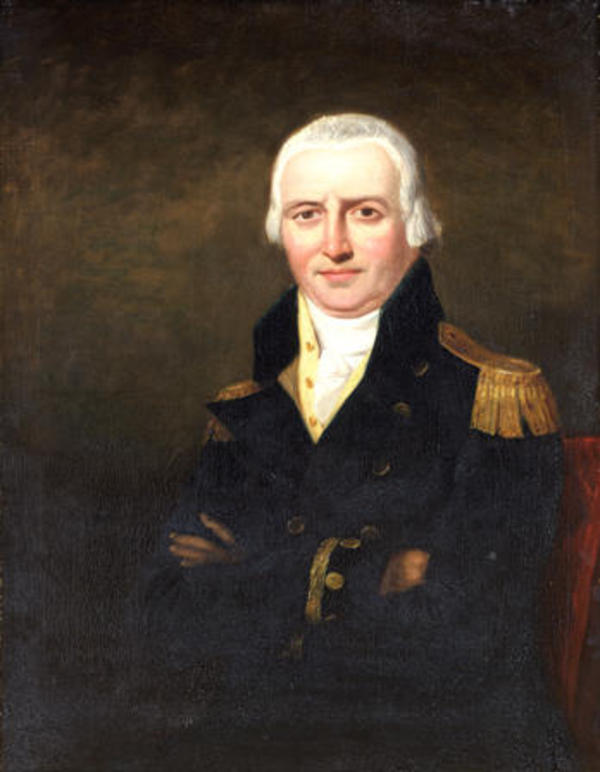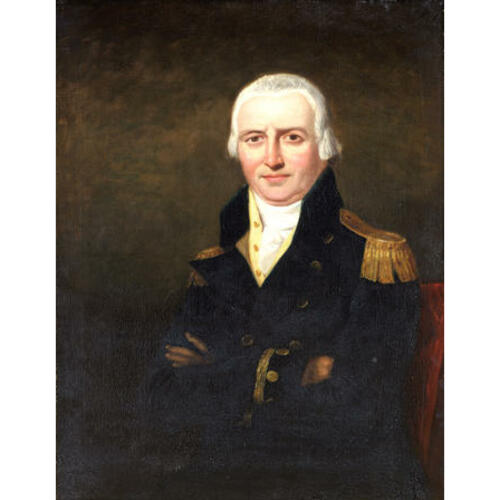
Source: Link
GOWER, Sir ERASMUS, naval officer and governor of Newfoundland; b. 3 Dec. 1742 near Cilgerran, Wales, eldest of 19 children of Abel Gower of Glanafon and Letitia Lewes; d. unmarried 21 June 1814 in Hambledon, Hampshire, England.
Erasmus Gower entered the Royal Navy in 1755 under the care of his uncle, Captain John Donkley. His service was extensive and varied. Between 1764 and 1766 he was on the Dolphin during the round-the world voyage of Commodore John Byron*, and in the latter year was promoted lieutenant. In March 1770 he was shipwrecked on the coast of Patagonia (Argentina), and reached the Falkland Islands only to be expelled by a Spanish force. During the American revolution he saw service in both the West and the East Indies and in January 1783, while in command of the frigate Medea, captured the Dutch East Indiaman Vrijheid at Cuddalore (India). Between 1786 and 1789 he was flag-captain to Commodore John Elliot on the Newfoundland station, and in 1792 he was knighted prior to his taking out to China, in the Lion, a British embassy under Lord Macartney. He also served under Sir William Cornwallis in an action off the French coast in 1795 and was present at the mutiny at the Nore in 1797. Although his British-biographies note that he held no “active employment” after his promotion to rear-admiral of the white in February 1799, his greatest service to Canada began with his promotion to vice-admiral of the white and his appointment as governor of Newfoundland in the spring of 1804.
Gower arrived at St John’s on 20 July 1804 and for the next three years followed the usual pattern of Newfoundland governors by remaining on the island over the summer and then returning to England in the autumn with the fishing fleet. The obvious care which he applied to the day-to-day administration of the island is exemplified in his meticulous annual returns of shipping and fishery statistics, to which he appended lengthy explanatory observations. Although he was greatly concerned with the defence of St John’s, much of his attention was concentrated on administration, in the long term, of all Newfoundland, which by the time of his tenure was clearly a year-round settlement, a “colonized” place. His earlier service there gave him a perspective on the changes which had occurred as the fishery altered from one with a large proportion of its vessels migrating seasonally from Britain into a sedentary one. Governor James Gambier*, Gower’s predecessor, who had also recognized these realities, had suggested the appointment of a permanent government secretary, the establishment of Protestant schools, the construction and rebuilding of jails, and the leasing of disused properties still reserved for the migratory fishing ships in acknowledgement of the changed conditions.
Gower agreed with Gambier’s measures, strengthened them, and extended them – no small feat in the tangle of approvals and entrenched policies then part of Newfoundland government. He retained Gambier’s secretary and pointed out persistently the importance of a permanent secretary to provide continuity. He worked diligently for a fair judicial system and adequate remuneration for its officials, reorganized their offices, and, to replace a system in which magistrates and clerks were paid directly from what they could collect, allocated fines and fees to a general fund from which commensurate salaries could be paid. He also took the charitable fund that had been started by Governor William Waldegrave and supported by his two successors, Sir Charles Morice Pole and Gambier, and built it into a society for improving the condition of the poor. The society provided for both the relief of the indigent and the instruction of children of both sexes in morality, reading, and practical skills. This latter development quickly resulted in the establishment of a large school building and an enrolment of 150 pupils. The institution had political and governmental importance as well, for the Roman Catholics had been more active than the Protestants in providing schooling. Gower did not hesitate to recommend that the government continue funding this educational effort. He emphasized government support for the Church of England in a number of ways, and he also strongly supported the attempt to obtain a salary and pension for the Roman Catholic bishop in Newfoundland, James Louis O’Donel, in recognition of his work with the “labouring class,” which had through his efforts remained loyal and peaceful in the nervous times of the Napoleonic Wars.
In a settlement that was growing, and in new directions, Gower recognized the importance of property and land for the support of the fishery and trade, for agriculture, and for housing. The ships’ rooms in St John’s, places on the harbour traditionally reserved for seasonal fishing vessels which arrived early from Britain, were no longer so used. Gambier had begun a quiet general survey of them; Gower extended the survey to much of the island and developed a policy to allow their being leased from the crown. To meet a pressing demand for agricultural land at St John’s, Gower, again following Gambier’s lead, made available on 21-year leases land back from the 200-yard strip traditionally reserved for fishery use, and by the end of 1805 this amounted to more than 300 acres. On the line of the 200-yard limit he laid out a street with house lots on its inland side. Rents from all these lands went for the support of the programs of the civil establishment and the Church of England.
Nevertheless, the official British attitude was still that Newfoundland should not become a colony. One of the main reasons was that the migratory ship fishery was seen as necessary to the continuance of the Newfoundland trade and as a training ground for the Royal Navy. Gower, however, compared the statistics of 1787–89, years of a peak in the Grand Banks fishery, with those for 1805 and showed that, although the migratory fishery had fallen away to little, shipping to and from the island in the latter year came close to employing the same number of men as had been engaged in the earlier period. A further official policy was that Newfoundland should rely on Britain for its supplies. Gower pointed out that the Newfoundland fishery had to remain competitive; otherwise it could not continue as a British exchange earner or as a “Nursery of Seamen.” If it were to be able to compete with the New England fishery it had to have a much freer hand in importing supplies from the cheapest market, and its people had to have the clear right to possess land and to grow more of their own food. Gower’s attitude to his instruction regarding the islanders’ clouded property rights illustrates the tenor of much of his three years of Newfoundland administration: “Conceiving it therefore to be impracticable, I should recommend it to be rescinded, or so altered as to recognize the existing customs, and thereby relieve the Governor from the embarrassment of holding an Instruction contrary to the nature and interest of the object which it is his duty to promote, and give confidence and encouragement to those who adventure in it.”
Gower left Newfoundland for the last time on 25 Oct. 1806, and his successor John Holloway* was appointed the following spring. He saw no further service, but was promoted admiral of the white on 31 July 1810.
A lithograph of a portrait of Gower is reproduced in W. L. Clowes, The Royal Navy: a history from the earliest times to the present (7v., London, 1897–1903), 4: 261.
PRO, CO 194/44: ff.3–3v, 5–8, 16, 17–47, 59, 62vff., 75v, 81, 113–16, 155–63v, 170, 201–5, 256v, 258v, 259–59v; 194/45: ff.14–16v, 26–27, 28v–32v, 34–39, 59–60, 78–81, 82–82v, 84–84v, 96–97, 107–8, 119–22, 129–34, 201–2, 233–35, 263–65v, 332–34. Gentleman’s Magazine, January—June 1814: 702; July–December 1814: 289–90. “Biographical memoir of Sir Erasmus Gower, knight,” Naval Chronicle, 4 (July–December 1800): 257–89; “Additional biographical memoir of Admiral Sir Erasmus Gower,” Naval Chronicle, 30 (July–December 1813): 265–301. DNB.
Cite This Article
C. Grant Head, “GOWER, Sir ERASMUS,” in Dictionary of Canadian Biography, vol. 5, University of Toronto/Université Laval, 2003–, accessed March 28, 2025, https://www.biographi.ca/en/bio/gower_erasmus_5E.html.
The citation above shows the format for footnotes and endnotes according to the Chicago manual of style (16th edition). Information to be used in other citation formats:
| Permalink: | https://www.biographi.ca/en/bio/gower_erasmus_5E.html |
| Author of Article: | C. Grant Head |
| Title of Article: | GOWER, Sir ERASMUS |
| Publication Name: | Dictionary of Canadian Biography, vol. 5 |
| Publisher: | University of Toronto/Université Laval |
| Year of revision: | 1983 |
| Access Date: | March 28, 2025 |



